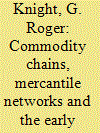| Srl | Item |
| 1 |
ID:
130577


|
|
|
|
|
| Publication |
2014.
|
| Summary/Abstract |
This paper discusses the foundational history of a major European mercantile house in colonial South East Asia in the context of commercial developments that had both a regional and global reach. In so doing, it seeks to relate a local and historically particular event to a broader world pattern defined by three rapidly evolving commodity chains, based respectively on the production, distribution and consumption of cotton goods, coffee and opium. In this context, the paper argues that the hard-won commercial success of the firm in question resulted from a significant degree of withdrawal from the bilateral ties between colony and metropolis inherent in the cotton and coffee commodity chains. In their place, the firm had recourse to several varieties of the inter-Asian trade, of which the opium commodity chain constituted the key dimension.
|
|
|
|
|
|
|
|
|
|
|
|
|
|
|
|
| 2 |
ID:
152006


|
|
|
|
|
| Summary/Abstract |
This article analyses the paradoxically central role of a railroad in Soviet economic growth in southern Tajikistan’s Vakhsh River valley during the 1930s. Constructed as a secondary service road of the Vakhshstroi agro-industrial complex, it was not meant to support enterprises throughout the region. Because of the republic’s lack of roads, however, unrelated freightage operations gravitated to the Vakhsh Railroad and made it the unintended mediator of the developing geography of Soviet movement. By examining how the narrow gauge line was used in unplanned ways, I find that state building under Stalin was characterized by improvisation in labour and mobility. Furthermore, the material conditions of transportation limited the locations of economic possibility in unanticipated ways. This case demonstrates that studying the use of infrastructure can further historical understanding of causes, effects and chronologies of economic life in the Stalin era.
|
|
|
|
|
|
|
|
|
|
|
|
|
|
|
|